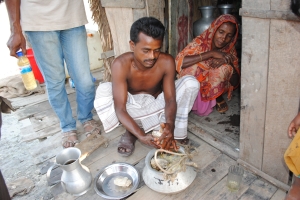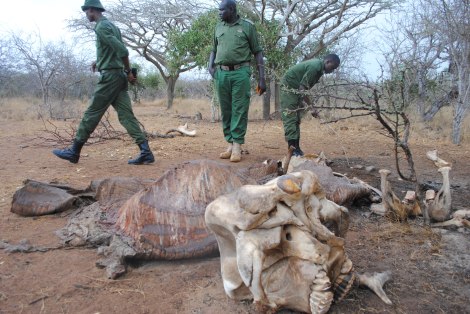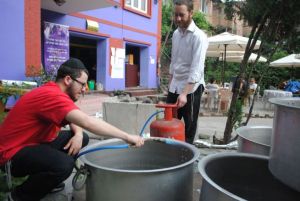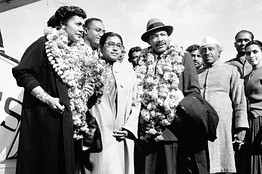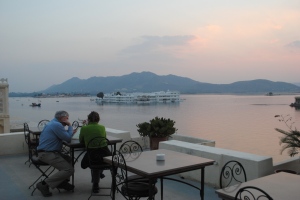Amy Yee @amyyeewrites is an award-winning journalist, currently with Chicago Sun-Times and previously with Bloomberg/CityLab, writing about in/equality and solutions to social problems.
She is a former staff reporter and foreign correspondent for the Financial Times in New York and India. Amy is an award-winning American journalist who was based in New Delhi, India from 2006-13,
* Won four South Asian Journalists Association (SAJA) international awards for Business, Commentary, Feature and Narrative articles for reporting from India, Bangladesh, Nepal; and named a SAJA awards finalist seven times, all for single byline stories.
* 2023 Chicago Journalists Association’s award for Best Business story and finalist for Best Technology story.
* Society of Environmental Journalists awards, 2020 honorable mention for climate solutions stories from Africa.
BYLINES
Amy’s articles have appeared in The New York Times, The Economist, Wall Street Journal, Washington Post, National Geographic, The Guardian, The Nation, The Atlantic.com, Foreign Policy.com, International Herald Tribune, NBCNews.com, Forbes, The Lancet, Science Magazine, Christian Science Monitor, ScientificAmerican.com, BBC Future, The Daily Beast, Undark (science magazine at MIT), Stanford Social Innovation Review, Boston Globe Magazine, Boston Globe, Ms. Magazine, Slate, The Progressive, Roads and Kingdoms, Yes! Magazine, Atlas Obscura, Afar Magazine, Global Post (US), OnEarth.com, Far Eastern Economic Review.com and Buddha Dharma magazine, among other publications.
She has reported from 20+ countries in total: India, Bangladesh, Nepal, Pakistan, Kenya, Democratic Republic of Congo, Rwanda, Ethiopia, Uganda, Ghana, Senegal, Tanzania/Zanzibar, Mozambique, Australia, Bosnia, Russia, Myanmar, Sweden, Peru, Tibet, Canada and the US Her produced radio work from Bangladesh, India, Africa and Australia has aired on NPR (National Public Radio) and Voice of America.
JOURNALISM FOCUS
From south Asia and Africa she wrote about ways to reduce poverty and to promote human and economic development; business; business approaches to reduce poverty; clean energy; public health; arts, culture and travel. She also wrote extensively on Tibet issues.
Her journalism focuses on solutions to social problems, such as improving safety in Bangladesh’s garment factories; reducing deaths of children and mothers; mitigating climate change through renewable energy; and much more. She has the most articles (85+) in the Solutions Journalism Network’s Story Tracker besides SJN’s founders, with many more stories not included. Amy discussed her solutions journalism with SJN here.
Amy is a graduate of Harvard Kennedy School, Columbia Journalism School, Wellesley College and has an MFA from Hunter College.

(Photo thanks to the amazing Women and Public Policy Program at Harvard Kennedy School)
- 2019 MacDowell fellow
- 2019 Logan Nonfiction Fellow
- 2014 Knight-Bagehot Fellow in Economics and Business Journalism at Columbia University where she also earned a master’s degree (and learned to produce radio stories).
- Grants from Pulitzer Center for Crisis Reporting, Solutions Journalism Network, Economic Hardship Reporting Project; McGraw Center at CUNY
PHOTOS
Her photos have appeared in the New York Times, Washington Post, NPR, International Herald Tribune, Forbes, Wall Street Journal, National Geographic.com, Economist.com, Financial Times, The Atlantic.com, The Nation, The Guardian, Christian Science Monitor, Boston Globe, The Lancet, Roads and Kingdoms, Voice of America (VOAnews.com), Undark, Buddha Dharma magazine, NBCNews.com, Atlas Obscura and Terrain.org.
RADIO/AUDIO STORIES
Amy researches, reports, field records interviews and ambient sound, writes and voices scripts, and edits tape, while doing all logistics, pre-production, travel planning in challenging locations. She uses a Marantz recorder, an RE 50 Mic (before it was stolen in DR Congo), and edits using Audacity.
NPR
“I’ve written about 1,000 journalistic articles across a wide range of subjects. On this website you will find more than 150 of the longer and more interesting and memorable ones. Below are a few selected articles; under the “Articles” tab above there are dozens more.
I started out in journalism writing about books, ideas, and arts and culture, with a focus on China (I lived in Nanjing for two years). I am personally interested in social change and cultural identity. Early in my career, I wrote this article for The Christian Science Monitor about a classical music program for inner-city kids. A few years later, the founder of this remarkable program went on to win a MacArthur “Genius” Fellowship.
From New York I wrote a lot about business and sometimes came across articles about social change, like this Vegas story for the Financial Times about training immigrants and giving them valuable job skills. Business is a fascinating lens through which to view the world.
As a freelancer, my journalism focused on human and economic development, poverty, business, and things that can improve lives, including clean energy, public health and education. I still write about arts and culture and their provocative role in the world.
Last but not least, I write frequently on Tibet issues due to my long-standing interest in cultural identity and social change. I wrote about my first encounter with the Dalai Lama when he hugged me in 2008 for the Financial Times here.”
Amy was born and raised in Boston, Massachusetts and publishes poetry under a pseudonym.
Selected Articles:
The Power Plants That May Save a Park, and Aid a Country
New York Times
“…the tiny power plant is crucial to an ambitious attempt not only to protect Virunga — Africa’s oldest national park — from threats including armed rebels, deforestation and oil prospectors, but to jump-start the local economy and potentially help stabilize one of the world’s worst conflict zones.”
Gold Winner, 2014 United Nations Correspondents Association Awards for coverage of climate change; Honorable Mention, Best American Essays 2015:
This Will All Be Underwater
Roads and Kingdoms, July 30, 2014
I talked to many people struggling to survive in the beautiful but harsh environment of Bangladesh’s Sundarbans, the UNESCO site and the world’s largest contiguous mangrove forest that is highly vulnerable to climate change.
“One afternoon three years ago, a tiger attacked Kamal Gazi as he was fishing on a riverbank in the mangrove forests of the Sundarbans. It is a miracle he is alive. The scars on his face start at the eyes and wrap around his head where black hair unevenly stripes his puckered scalp.
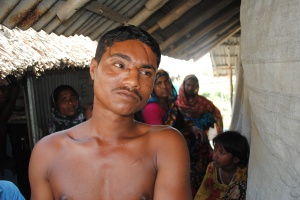
Kamal Gazi’s face bears deep scars from a tiger who attacked him while fishing in the Sundarbans. Photo: Amy Yee
Gazi was fishing with a fellow villager who bravely managed to beat off 450 pounds of feline muscle with a stick. That’s how he survived an attack by one of the infamous man-eating tigers of the Sundarbans, the world’s largest contiguous block of mangroves covering southwest Bangladesh. So much for the myth that these swimming tigers attack only from behind and never in broad daylight. Gazi was lucky; at least 50 people are killed by tigers each year here.”
…
And:
On the edge of a riverbank, 28-year-old Saiful Islam squats outside his thatch home where his wife and two sons, ages 2 and 4, also live. He went into the forest alone that morning and emerged with honey five hours later. Islam squeezes the chunks of honeycomb like big sponges over a battered metal pot so they drip clear streams of sweet liquid. The geometric chambers of the greyish honeycomb resemble scaly fish hunks. Islam picks dead bees out of the honey, then strains it with the blue plastic mesh of a fishing net into a plastic bottle. Two kilograms will earn him 700 taka, about $9.
Islam’s family was out of food. Honey is the quickest way to make money so he went five miles into the forest, and climbed an 18-foot tree after smoking bees from their hive.
A long sleeved shirt over his lungi, a scarf over his face, and a red string folk amulet wound around his bicep were his only protection. Even the Bangladeshi Relief International workers accompanying me remark on his courage. A gaggle of children and neighbors gather around Gazi to admire the year’s first honey harvest.
Gazi’s wife says she prays to ‘’almighty Allah’’ to keep her husband safe when he crosses the river and disappears into the mangroves.” CONTINUE READING
In Kenya, a Transformation in Shades of REDD
Communities near the Rukinga Sanctuary once seemed locked on a path of resource decimation. But here, at least, a global conservation plan is working.
Undark (science magazine at MIT)
Long form narrative about stopping poaching and cutting down forest for cooking fuel by creating jobs in a poor community through carbon credits.
“HERE IS WHAT a dead elephant looks like: Rib bones longer than my arm scattered across red dirt. Over here is a lower jaw, beached and desolate like the broken hull of a ship. Over there is the massive boulder of its skull. Behind the gaping eye sockets is a web of porous bone, a hideous honeycomb. Shreds of gray skin are strewn across the soil like filthy rags, and hyenas have dragged and scattered bits of the elephant’s remains over this final resting ground. The scavengers feast even on the bones, and they leave behind clumps of chalky dung that are vivid against the rust-colored soil…GO TO ARTICLE
Photo: Amy Yee
“Outstanding Piece of Literary Non-Fiction” in the 2017 South Asian Journalists Association’s (SAJA) contest; Notable Essay, Best American Essays 2017.
Delhi’s Current Flows On
A walk in India’s capital with Akhil Sharma, winner of the 2016 International Dublin Literary Award
“I took the Metro across the city’s sprawl, from New Delhi, the British-designed part inaugurated in 1931, up past Old Delhi, the northern section founded by a Mughal emperor three hundred years earlier. I’ve come to nearly the end of the line, to a northwest neighborhood that tourists have no reason to visit. I had been living in Delhi nearly five years, but I would see the city in a different way: through the eyes of an author whose first book is set in the city of his early childhood and whose second book starts here before its narrator emigrates to the U.S. I’ll follow Sharma as he visits relatives and family friends in three neighborhoods of north Delhi, as though doing a walking tour of his childhood memories. We’ll be traversing different worlds, touring the love and loathing of families, the present overlaid on the past, and places and memories transformed into fiction.” GO TO ARTICLE
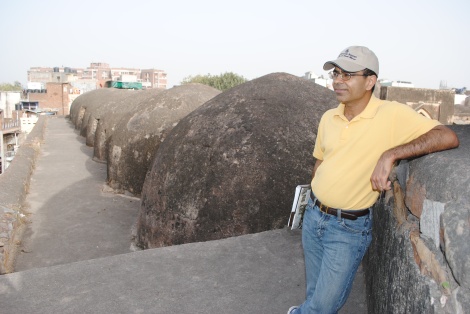
Photo: Amy Yee
Outstanding Business Story in the 2016 South Asian Journalists Association’s (SAJA) contest; Notable Essay, Best American Essays 2016.
Exporting Clothes, Importing Safety
Roads and Kingdoms, August 2015
Long form analysis about the challenges of reforming Bangladesh’s garment factories after the 2013 collapse of Rana Plaza, the world’s worst factory disaster. GO TO ARTICLE
“Bangladesh, whose garment industry is second only to China’s in size, is responding to both international and domestic pressure and undergoing the most radical revamping of worker safety it has ever seen. The south Asian country is almost halfway through a five-year plan to bring more than 3,500 export garment factories up to international safety standards by 2018. More than 200 of the world’s biggest clothing brands and retailers—including H&M, Walmart, Target, Zara, Marks and Spencer, Adidas, L.L. Bean, and Benetton—have pledged to do business only with factories that comply…”
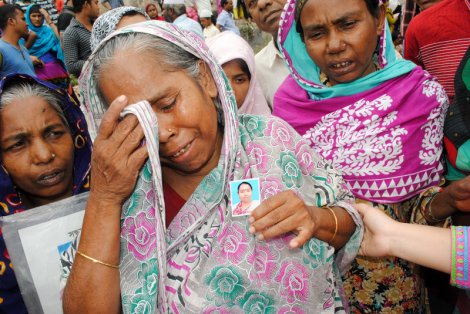
Two years after the collapse of the factory at Rana Plaza, families of victims gather, holding photos of their lost loved ones. (Amy Yee for NPR)
Far From the Rooftop of the World
“Indian pop music blasted within the autorickshaw and the flimsy metal buggy chugged to a raucous dance beat as we bumped along the road to Bylakuppe. The plump, middle-aged Tibetan woman squeezed into the back seat next to me wasn’t happy. She barked something to the Indian driver in Hindi and he called back over his shoulder as he dodged a jeep roaring at us from the opposite direction. He wore plastic flip-flops but had taken them off so he pressed the pedals with his callused bare feet. “What’s the matter?” I asked her.” GO TO ARTICLE
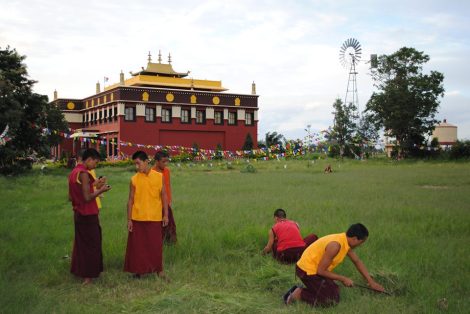
First Place for Public Health Reporting in the 2013 Association of Healthcare Journalists contest
Defying the odds: Bangladesh makes strides in child health
GlobalPost, June 25, 2013
Counter to the common perception of Bangladesh as hopelessly impoverished, the country has dramatically reduced overall child mortality in recent decades. Part of a five-part series about child mortality around the world.
“When Hashi Akhter delivered her baby on a January morning in her thatched home in Dergram Village, she knew something was wrong right away. The baby was not crying.
She couldn’t breathe. Hashi had already been in labor much of the night. As morning broke, a relative went on foot to find a health worker near this remote village more than two hours north of Dhaka, Bangladesh’s capital.
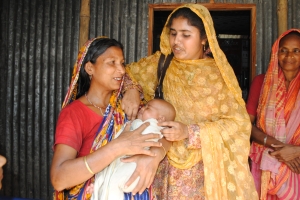
In Dergram village in Bangladesh, health worker Shefali Akhter (right) saved this baby from asphyxia moments after delivery by the mother (left). “The mother told me, ‘You saved my child.’ Now she loves me very much,” said Shefali. Photo: Amy Yee
That decision saved the baby’s life. Shefali Akhter, a 24-year-old government health assistant, is also a skilled birth attendant with special training on neonatal asphyxia, one of the largest killers of newborns in Bangladesh. (Shefali has no relation to Hashi.)
Shefali quickly cleared mucus and fluids from the baby’s mouth so that she could take her first breath in the “golden minute,” the small window of time in which decisions can mean the difference between life and death…
Counter to the common perception of Bangladesh as hopelessly impoverished, the country has made dramatic strides in reducing overall child mortality in recent decades. Bangladesh is on track to achieve Millennium Development Goals (MDGs) 4 and 5, which aim to reduce under-5 child and maternal mortality, respectively. In fact, Bangladesh is one of only eight countries to have reduced its under-5 mortality rate by at least two-thirds since 1990. ”
Winner for Best Commentary, 2013 South Asian Journalists Association awards
In India, a Small Pill, With Positive Side Effects
New York Times April 4, 2012
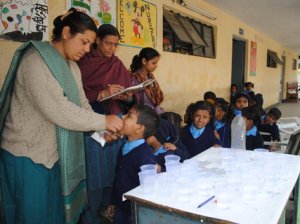
Teachers in Delhi distribute pills to rid young students of intestinal worms in spring 2012. Photo: Amy Yee
On a cool February morning in north Delhi, India, 35 third graders sat at small desks in a spartan but tidy classroom. They wore blue school uniforms and listened as their teacher asked in Hindi if they had had intestinal worms.
A third of the children raised their hands, including 9-year-old Arjun Prasad. He sometimes felt stomach pain and weakness — symptoms of severe infection — he said. A few minutes later, Arjun and his classmates were given deworming pills, and took them during the class. They were among the 3.7 million children in Delhi who have taken the pills as part of a recent campaign in India’s capital to stamp out the widespread but neglected ailment.
Intestinal worms are pervasive in the developing world and can have devastating effects. But there is growing awareness about how easy and inexpensive it is to treat worms, as well as surprising longer-term socioeconomic benefits. Research shows deworming to be extremely cost-effective: you get a lot of bang for your buck… GO TO ARTICLE
Winner in Best Arts & Culture category, 2013 South Asian Journalists Association Awards
1,100 Pounds of Matzo in Kathmandu: Welcome to the World’s Largest Seder
Atlantic.com, April 12, 2012
In what has become an annual tradition, 1,100 mostly Israeli travelers gathered in Kathmandy to celebrate Passover — with plenty of kosher wine. The tradition begins with the steady influx of young Israeli backpackers. They usually travel after their required stint in the army, from age 18 to 21, and before university. Israelis come to Nepal to hike, river raft, bungee jump, hang out in cafés, and generally let down their hair, often literally…GO TO ARTICLE
Bangladesh’s Chance to Get it Right
New York Times, April 23, 2014

Workers at shipbuilder Western Marine, which dramatically reduced workplace injuries. Photo: Din Muhammad Shibly
“Bangladesh has more than 5,000 garment factories, but a year ago there were only 19 factory inspectors for all of them, and about as many fire and building inspectors. The disaster at Rana Plaza — which lacked permits for industrial use, and where rampant local corruption had allowed extra floors to be added illegally — also highlighted the wider problem of unsafe construction. Inspecting buildings is more expensive and complicated than other checks because it requires engineering analysis and possibly lab testing of foundation materials.
Improving garment factories is imperative for Bangladesh. After the Rana Plaza collapse, the backlash against global retailers and the “made in Bangladesh” label was harsh and swift. Yet ordinary Bangladeshis would suffer if apparel companies pulled out of the country. Bangladesh is the second largest maker of “ready-made garments” after China. The industry helped annual economic growth reach 6 percent in recent years; garments represent more than 80 percent of the country’s exports. Bangladesh’s garment factories employ about 3.8 million people, most of whom are women…
The challenge then is how to improve workplace safety in Bangladesh meaningfully and sustainably with limited resources. This is an enormous, highly complicated task, but ambitious plans were put in place in the wake of the Rana Plaza collapse… GO TO ARTICLE
Autism Research’s Overlooked Racial Bias
Despite popular belief, white kids aren’t the only ones on the spectrum. Minority families often miss out on treatment or get left out of research — an ethical failure. New projects are illuminating autism’s diverse shades.
TheAtlantic.com / Spectrum
“…[these] stories hint at some reasons why minorities are underrepresented in studies of autism and have little access to treatment options. Broad socioeconomic, cultural, and language barriers keep minority families from participating in both domains. New studies are delving into ways to recruit and retain minorities in research, as well as developing better screening, support, and treatment programs, all of which can bridge the gaps that lead to the exclusion of these groups.” GO TO ARTICLE

Photo: Working together: Amalia Contreras (left) of the California-based nonprofit Fiesta Educativa, answers Patricia Sanchez’s questions about her child’s autism. Photographs by Jenna Schoenefeld
Medical reforms urged to tackle violence against women in India
India’s medical system needs to be more responsive to the needs of women who have been victims of interpersonal violence, say experts and campaigners.
The Lancet
“Nearly every day at least one woman comes to Mumbai’s public hospitals seeking treatment for bruises, burns, or poisoning. In the past, such injuries were usually treated as accidents by doctors and victims who tacitly knew they were the result of domestic or sexual violence. “Everyone knows that a woman doesn’t accidentally drink half a bottle of pesticide”, said Padma Deosthali, director of the Center for the Enquiry into Health and Allied Themes (CEHAT), a non-governmental organisation (NGO) in Mumbai. “It’s a conspiracy of silence.” In India, it is not uncommon for women to poison themselves in an attempt to escape abuse, but the reasons behind this desperate act are often glossed over by medical staff…” GO TO ARTICLE
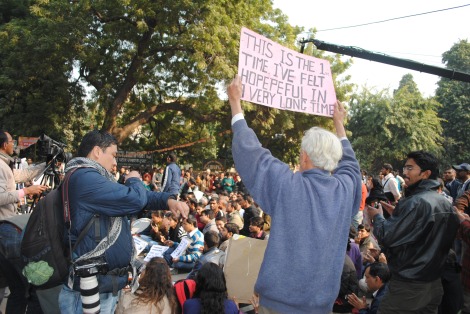
A placard at a protest in Delhi after the brutal gang rape of a 23-year-old in 201 reads, ‘This is the most hopeful I’ve felt in a very long time” Photo: Amy Yee
King of India
Wall Street Journal Asia, February 27, 2009
Gandhi was a source of inspiration for Martin Luther King Jr. GO TO ARTICLE
The King family has a long, but little-known, history in India. Martin Luther King Jr. was deeply influenced by Gandhi’s freedom struggle and spent a month in India from February 1959 learning firsthand about his doctrine of nonviolent resistance against British rule. GO TO ARTICLE
Tibetan exiles: ‘We Shall Overcome’
The Nation, February 25, 2009
For the pro-Tibet movement, better nonviolence training and education have been critical to stepping up the campaign in the hills of Dharamsala and far beyond. GO TO ARTICLE

Photo: Reuters. A Tibetan exile in Dharamsala protests the Beijing Olympic Games in 2008. The poster says, Release Political Prisoners.
Although it is their winter holiday, about sixty Tibetan students are attending this two-week workshop on “active nonviolence,” led by the Active Non-Violence Education Center (ANEC) in Dharamsala, the northern Indian hill town that has been home to the Dalai Lama for nearly fifty years. Over the next few days ANEC will lead a workshop based on the teachings of Gene Sharp, who outlined 198 methods of nonviolent action in his 1973 book, The Politics of Nonviolent Action... GO TO ARTICLE
-
The Dalai Lama’s Embrace
Financial Times, March 20, 2008
…The Dalai Lama asked what part of China my parents hailed from and exclaimed “Ni hao”, or “hello” in Mandarin. Only talks between Tibetan leaders and their Chinese counterparts would resolve the conflict engulfing his homeland, he offerred. Then Tibet’s spiritual leader clasped me to him and gave me a bear hug… READ MORE
In New Delhi, Sampling India’s Regional Food
New York Times
Like those of the other 27 states, the cafeteria at Andhra Pradesh’s center in the capital serves its regional cuisine.
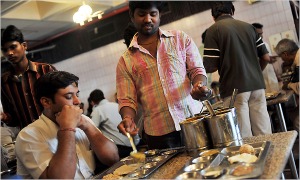
Like those of the other 27 states, the cafeteria at Andhra Pradesh’s center in the capital serves its regional cuisine. Photo: Keith Bedford for The New York Times
Each of India’s 28 states has its own government-run house for state affairs, known as a bhavan, in the bustling capital city of New Delhi. And most of the bhavans have a canteen that specializes in regional cuisine, whether it’s the coconut-infused dishes of the southwest state of Kerala, or the Chinese-style momos, or dumplings, of Sikkim in the northeast… GO TO ARTICLE
Showing and saving arts as old as centuries in India
Boston Globe
Travels to the heart of Udaipur in northern India, a city known for royal palaces, luxury hotels, and traditional arts. GO TO ARTICLE
The young puppeteer insists it’s easy. With outstretched hands, he pulls the strings on the foot-tall man at his feet. The puppet shakes its head coquettishly; wood and cloth suddenly seem human. “Try,’’ says the puppeteer, offering me the strings. I shake my head, imagining the knots I would make; I’m content to watch him work his magic… GO TO ARTICLE
Lunch with the FT: Wynn’s World
Financial Times, April 22, 2006
Lunch with Steve Wynn, the iconic founder of modern Las Vegas.
Just before I go in to see Steve Wynn, one of his staff asks if I like dogs. As soon as I enter the casino magnate’s office in Wynn Las Vegas, his new $2.7bn casino-resort, I understand the question: two German Shepherds lie by his feet under his desk. A third dog, a sleepy cocker spaniel, ambles across the plush carpet and carefully sniffs me.
Wynn, clad in black, is reading a letter at his desk. “Just a minute,” he intones. As I wait, I stroke the spaniel and look at the large Mark Rothko painting on the wall. A Basquiat hangs near by. Finally he looks up and greets me with a steady gaze. He doesn’t bother with niceties, throws a black blazer over his black turtleneck, slips on a pair of aviator sunglasses and heads off to choose one of the casino’s 22 restaurants for lunch… READ MORE
SAMPLE RADIO STORIES
at https://soundcloud.com/julep-gandhi
Fire Doors And Sprinklers Debut At Garment Factories In Bangladesh
NPR
Fire Doors And Sprinklers Debut At Garment Factories In Bangladesh https://www.npr.org/sections/goatsandsoda/2015/01/17/377742762/fire-doors-and-sprinklers-debut-at-garment-factories-in-bangladesh
[As a ‘solution’ for underfunded journalists and writers (me), I am experimenting with virtual tip jars, both powered by PayPal! If you want to donate, two options here: https://www.buymeacoffee.com/AmyYeeWrites and https://ko-fi.com/amyyee ]
Sample radio stories at https://soundcloud.com/julep-gandhi

